instrument panel MAZDA MODEL 3 HATCHBACK 2020 Owners Manual (in English)
[x] Cancel search | Manufacturer: MAZDA, Model Year: 2020, Model line: MODEL 3 HATCHBACK, Model: MAZDA MODEL 3 HATCHBACK 2020Pages: 598, PDF Size: 89.37 MB
Page 71 of 598
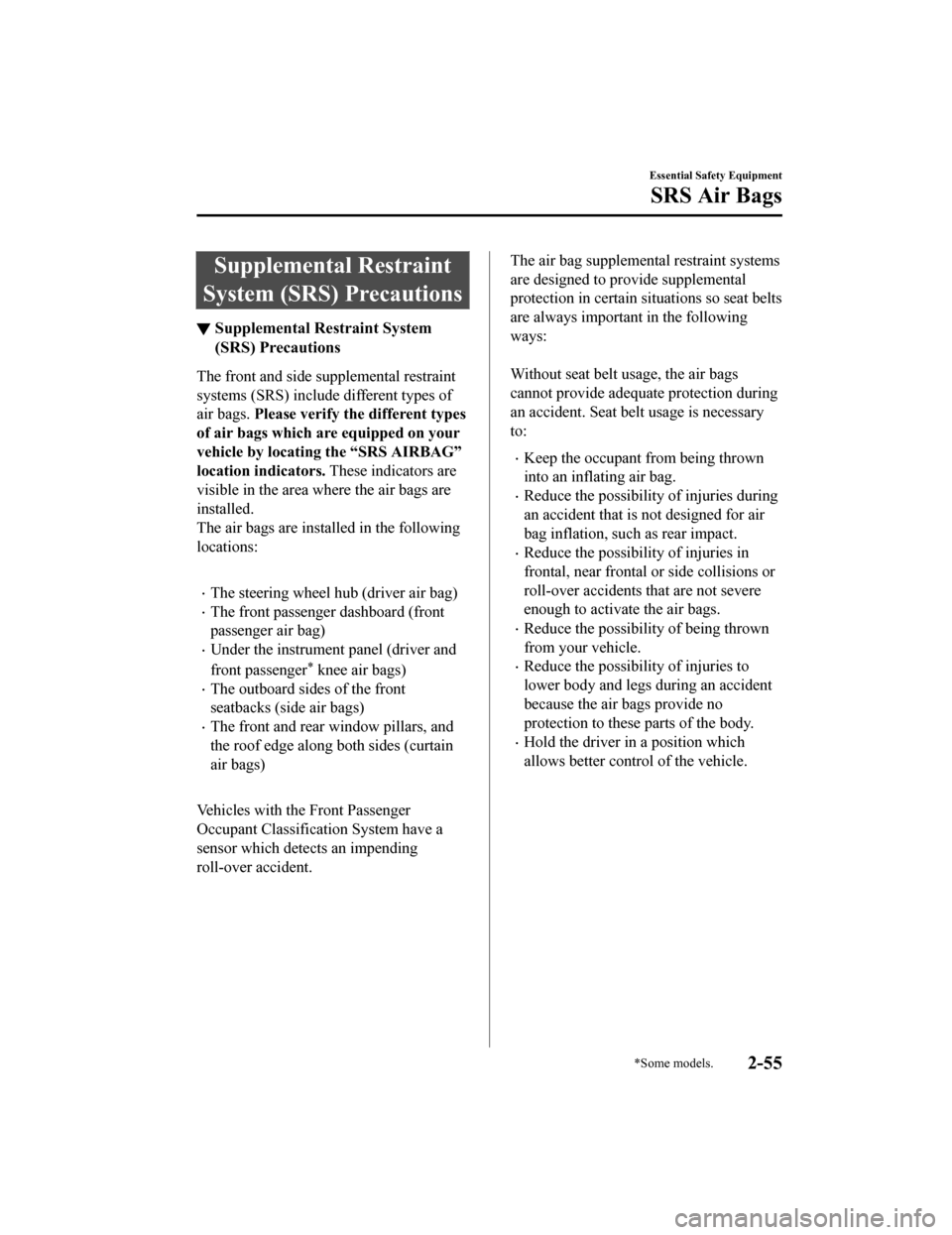
Supplemental Restraint
System (SRS) Precautions
▼ Supplemental Restraint System
(SRS) Precautions
The front and side supplemental restraint
systems (SRS) include
different types of
air bags. Please verify the different types
of air bags which are equipped on your
vehicle by locating the “SRS AIRBAG”
location in dicators. These indicators are
visible in the area where the air bags are
installed.
The air bags are insta lled in the following
locations:
The steering wheel hub (driver air bag)
The front passenger dashboard (front
passenger air bag)
Under the instrument panel (driver and
front passenger
* knee air bags)
The outboard sides of the front
seatbacks (side air bags)
The front and rear window pillars, and
the roof edge along both sides (curtain
air bags)
Vehicles with the Front Passenger
Occupant Classification System have a
sensor which detects an impending
roll-over accident.
The air bag supplemental restraint systems
are designed to provide supplemental
protection in certain situations so seat belts
are always important in the following
ways:
Without seat belt usage, the air bags
cannot provide adequate protection during
an accident. Seat belt usage is necessary
to:
Keep the occupant from being thrown
into an inflating air bag.
Reduce the possibility of injuries during
an accident that is not designed for air
bag inflation, such as rear impact.
Reduce the possibility of injuries in
frontal, near frontal or side collisions or
roll-over accidents that are not severe
enough to activate the air bags.
Reduce the possibility of being thrown
from your vehicle.
Reduce the possibility of injuries to
lower body and legs during an accident
because the air bags provide no
protection to these p arts of the body.
Hold the driver in a position which
allows better control of the vehicle.
Essential Safety Equipment
SRS Air Bags
*Some models.2-55
Mazda3_8HZ1-EA-19G_Edition1_old 2019-5-17 13:49:03
Page 81 of 598
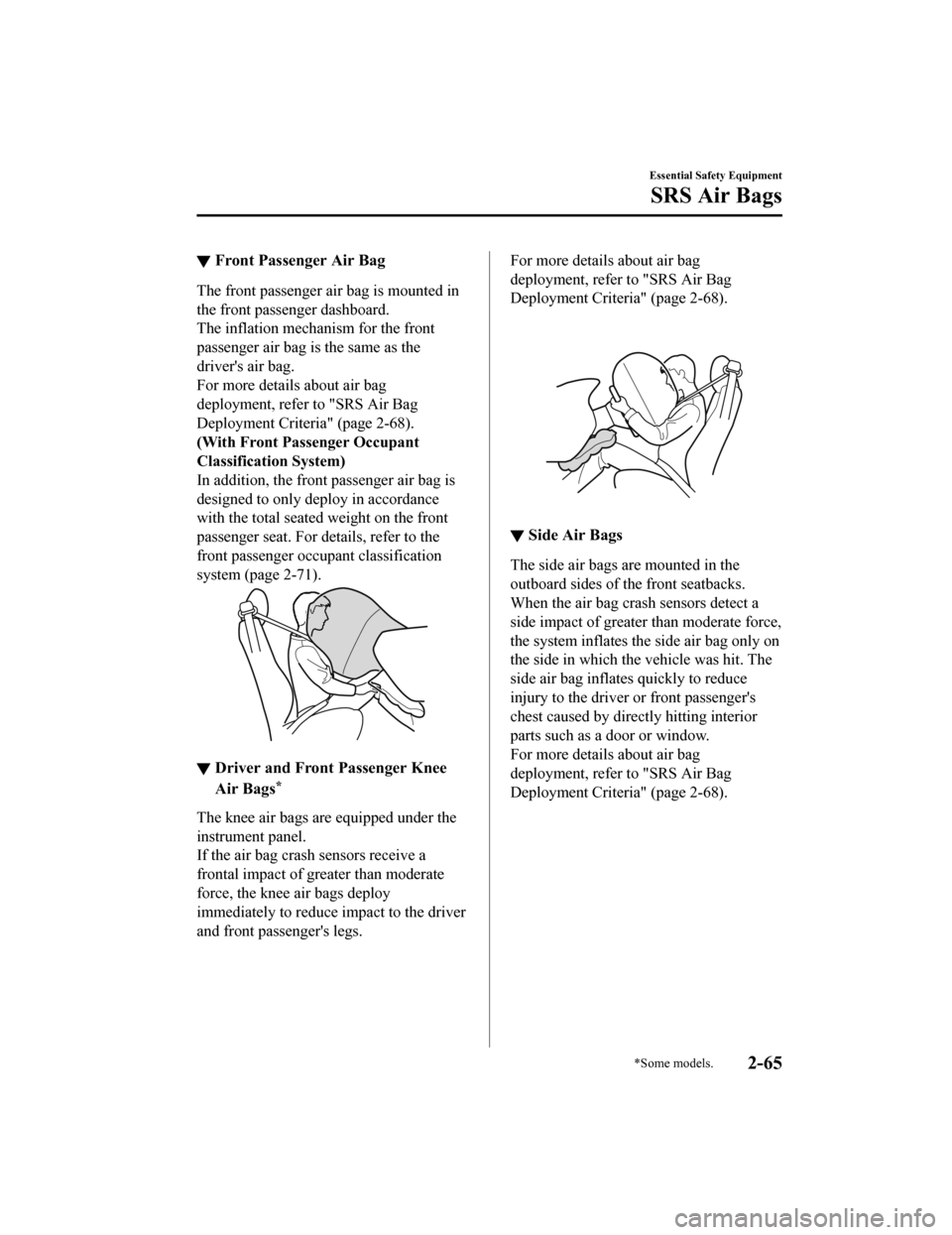
▼Front Passenger Air Bag
The front passenger air bag is mounted in
the front passenger dashboard.
The inflation mechanism for the front
passenger air bag is the same as the
driver's air bag.
For more details about air bag
deployment, refer to "SRS Air Bag
Deployment Crite
ria" (page 2-68).
(With Front Passenger Occupant
Classification System)
In addition, the front passenger air bag is
designed to only deploy in accordance
with the total seated weight on the front
passenger seat. For details, refer to the
front passenger occupant classification
system (page 2-71).
▼ Driver and Front Passenger Knee
Air Bags*
The knee air bags are equipped under the
instrument panel.
If the air bag crash
sensors receive a
frontal impact of greater than moderate
force, the knee air bags deploy
immediately to reduce impact to the driver
and front passenger's legs.
For more details about air bag
deployment, refer to "SRS Air Bag
Deployment Criteria" (page 2-68).
▼ Side Air Bags
The side air bags are mounted in the
outboard sides of the front seatbacks.
When the air bag crash sensors detect a
side impact of greater than moderate force,
the system inflates the side air bag only on
the side in which the vehicle was hit. The
side air bag inflates quickly to reduce
injury to the driver or front passenger's
chest caused by directly hitting interior
parts such as a door or window.
For more details about air bag
deployment, refer to "SRS Air Bag
Deployment Criteria" (page 2-68).
Essential Safety Equipment
SRS Air Bags
*Some models.2-65
Mazda3_8HZ1-EA-19G_Edition1_old
2019-5-17 13:49:03
Page 162 of 598
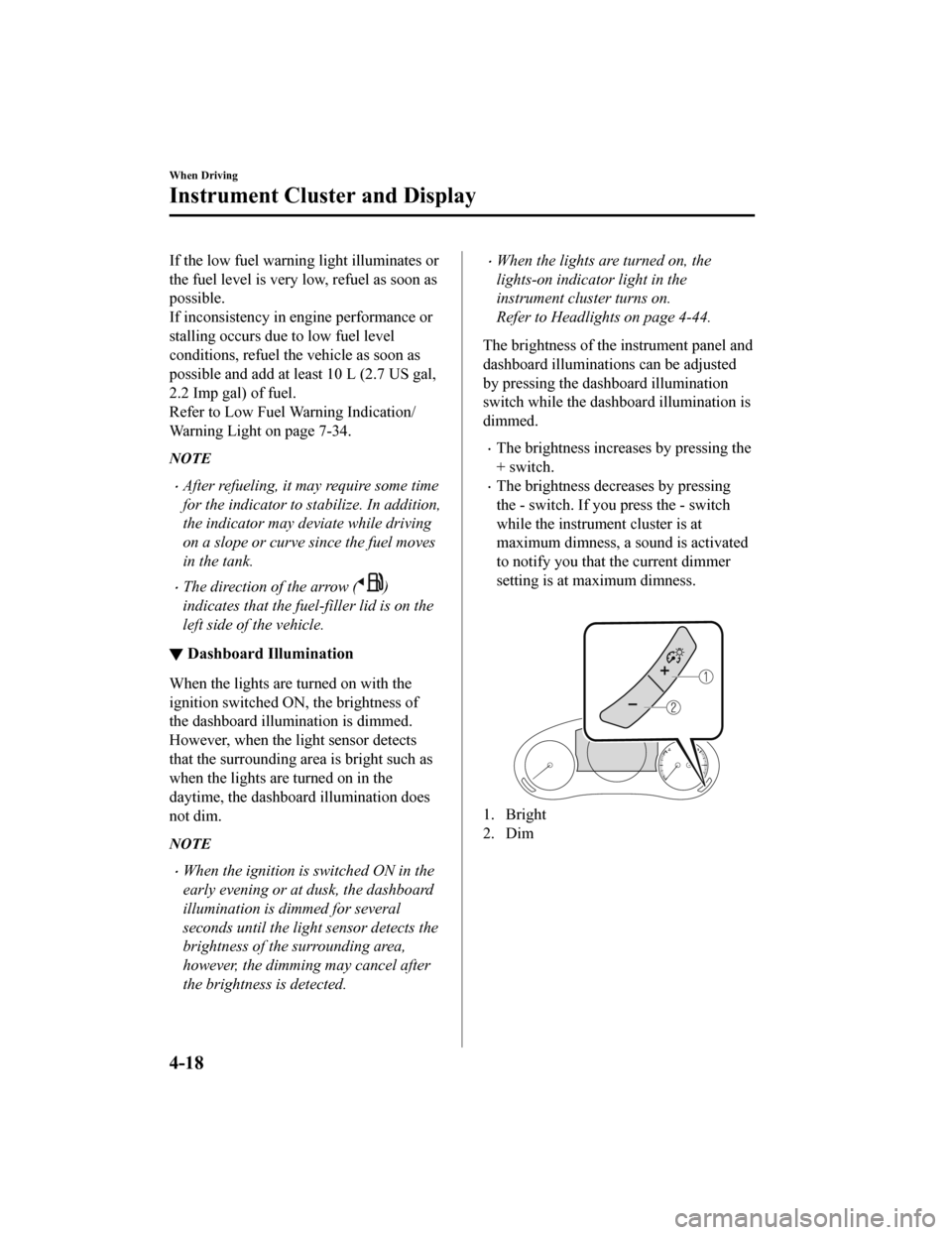
If the low fuel warning light illuminates or
the fuel level is very low, refuel as soon as
possible.
If inconsistency in engine performance or
stalling occurs due to low fuel level
conditions, refuel the vehicle as soon as
possible and add at least 10 L (2.7 US gal,
2.2 Imp gal) of fuel.
Refer to Low Fuel Warning Indication/
Warning Light on page 7-34.
NOTE
After refueling, it may require some time
for the indicator to stabilize. In addition,
the indicator may deviate while driving
on a slope or curve since the fuel moves
in the tank.
The direction of the arrow ()
indicates that the fuel -filler lid is on the
left side of the vehicle.
▼ Dashboard Illumination
When the lights are turned on with the
ignition switched ON, the brightness of
the dashboard illumination is dimmed.
However, when the light sensor detects
that the surrounding area is bright such as
when the lights are turned on in the
daytime, the dashboard illumination does
not dim.
NOTE
When the ignition is switched ON in the
early evening or at dusk, the dashboard
illumination is dimmed for several
seconds until the light sensor detects the
brightness of the surrounding area,
however, the dimming may cancel after
the brightness is detected.
When the lights are turned on, the
lights-on indicator light in the
instrument cluster turns on.
Refer to Headlights on page 4-44.
The brightness of the instrument panel and
dashboard illuminations can be adjusted
by pressing the dashboard illumination
switch while the dashbo ard illumination is
dimmed.
The brightness increases by pressing the
+ switch.
The brightness decreases by pressing
the - switch. If you press the - switch
while the instrument cluster is at
maximum dimness, a sound is activated
to notify you that the current dimmer
setting is at maximum dimness.
1. Bright
2. Dim
When Driving
Instrument Cluster and Display
4-18
Mazda3_8HZ1-EA-19G_Edition1_old 2019-5-17 13:49:03
Page 181 of 598

▼Indications
1. Manual shift mode indication
2. Gear position indication
Manual shift mode indication
In manual shift mode, the “M” of the shift
position indication in the instrument panel
illuminates.
Gear position indication
The numeral for the selected gear
illuminates.
NOTE
If the gears cannot be shifted down
when driving at higher speeds, the gear
position indication will flash twice to
signal that the gears cannot be shifted
down (to protect the transmission).
If the automatic transmission fluid
(ATF) temperature becomes too high,
there is the possibility that the
transmission will switch to automatic
shift mode, canceling manual shift mode
and turning off the gear position
indication illuminati
on. This is a normal
function to protect the AT. After the ATF
temperature has decreased, the gear
position indication illumination turns
back on and driving in manual shift
mode is restored.
▼ Manually Shifting Up
You can shift gears up by operating the
selector lever or
the steering shift
switches
*.
M1 → M2 → M3 → M4 → M5 → M6
Using selector lever
To shift up to a hig her gear, tap the
selector lever back + once.
Using steering shift switch*
To shift up to a higher gear with the
steering shift switches, pull the UP switch
(+/OFF) towa rd you once with your
fingers.
1. UP switch (+/OFF)
When Driving
Automatic Transmission
*Some models.4-37
Mazda3_8HZ1-EA-19G_Edition1_old 2019-5-17 13:49:03
Page 436 of 598

Scheduled Maintenance
▼Scheduled Maintenance (U.S.A. and Puerto Rico)
Vehicles utilizing the vehicle status monitor feature:
The vehicle status monitor featur
e alerts you of maintenance needs by turning on the wrench
indicator light or displaying a message in the instrument panel , or both.
Every maintenance must be done when the display/wrench indicati on comes on. The dis‐
play/wrench indication will come on before reaching the maximum interval of 16,000 km
(10,000 miles), or 12 months (after the previous maintenance).
If you drive your vehicle under any of the following conditions , follow the Severe Driving
Scheduled Maintenance and replace the engine oil and filter eve ry 8,000 km (5,000 miles)
or 6 months, whichever comes first.
Otherwise, follow the Normal Driving Scheduled Maintenance inte rvals.
1. The vehicle is idled for long periods or driven at low speeds , such as with police cars,
taxis, or driver's education school car.
2. Driving under dusty conditions.
3. Driving for long periods in co ld temperatures or driving regularly for short distances on‐
ly.
4. Driving under extremely high temperature conditions.
5. Driving continuously in mountainous regions.
If you are following the Severe Driving Scheduled Maintenance ( 8,000 km (5,000 miles) or
6 months oil replacemen t interval), set the vehicle status moni tor manually.
Refer to the Information section in the Mazda Connect Owner's M anual. Please contact an
Authorized Mazda Dealer if necessary.
USA and Puerto Rico Residents (Normal Driving Scheduled Mainten ance):
Maintenance ItemNormal Driving Scheduled Maintenance Intervals
1st 2nd 3rd 4th 5th 6th 7th 8th
Engine oil & filter
*1RRRRRRRR
Spark plug Replace every 12 0,000 km (75,000 miles).
Air filter RR
Drive belts IIIIIIII
Engine coolant level IIIIIIII
Engine coolant
*2Replace at first 192,000 km ( 120,000 miles) or 120 months;
after that, every 96,000 km (60,000 miles) or 60 months.
Fuel lines & hoses
*3IIII
Hoses and tubes for emission
*3II
Brake lines, hoses and connections I I I I
Vacuum brake booster and hose With vacuum
boosterIIII
Maintenance and Care
Scheduled Maintenance
6-4
Mazda3_8HZ1-EA-19G_Edition1_old
2019-5-17 13:49:03
Page 440 of 598
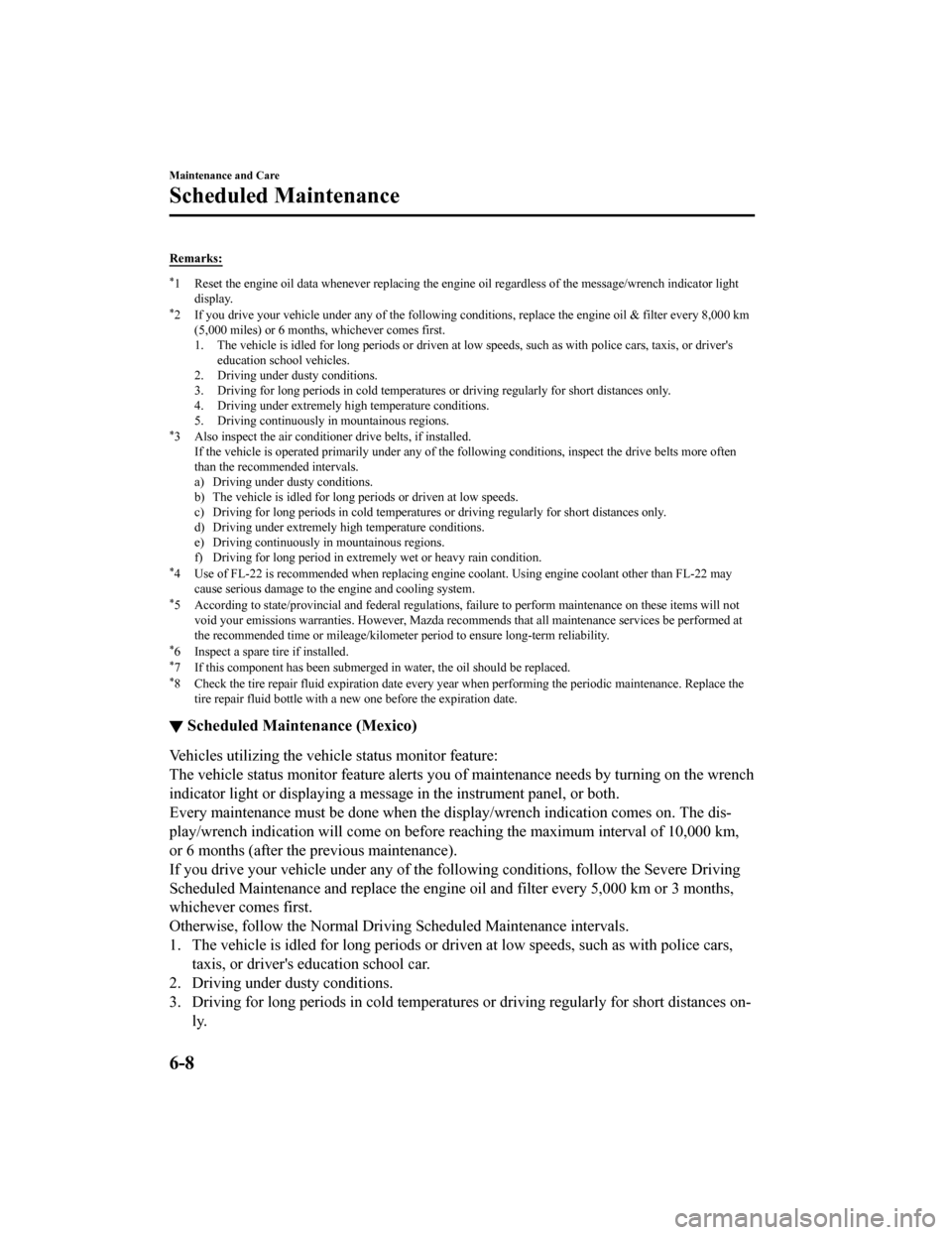
Remarks:
*1 Reset the engine oil data whenever replacing the engine oil regardless of the message/wrench indicator light
display.
*2 If you drive your vehicle under any of the following condition s, replace the engine oil & filter every 8,000 km
(5,000 miles) or 6 months, whichever comes first.
1. The vehicle is idled for long periods or driven at low speeds , such as with police cars, taxis, or driver's
education school vehicles.
2. Driving under dusty conditions.
3. Driving for long periods in cold temperatures or driving regu larly for short distances only.
4. Driving under extremely high temperature conditions.
5. Driving continuously in mountainous regions.
*3 Also inspect the air conditioner drive belts, if installed. If the vehicle is operated primarily under any of the following conditions, inspect the drive belts more often
than the recommended intervals.
a) Driving under dusty conditions.
b) The vehicle is idled for long periods or driven at low speeds.
c) Driving for long periods in cold temperatures or driving regu larly for short distances only.
d) Driving under extremely high temperature conditions.
e) Driving continuously in mountainous regions.
f) Driving for long period in extremely wet or heavy rain condit ion.
*4 Use of FL-22 is recommended when replacing engine coolant. Using engine coolant other than FL-22 may
cause serious damage to the engine and cooling system.
*5 According to state/provincial and federal regulations, failure to perform maintenance on these items will not
void your emissions warranties. H owever, Mazda recommends that all maintenance services be performed at
the recommended time or mileage/kilometer period to ensure long -term reliability.
*6 Inspect a spare tire if installed.*7 If this component has been submerged in water, the oil should be replaced.*8 Check the tire repair fluid expiration date every year when performing the periodic maintenance. Replace the
tire repair fluid bottle with a ne w one before the expiration date.
▼Scheduled Maintenance (Mexico)
Vehicles utilizing the vehicle status monitor feature:
The vehicle status monitor featur
e alerts you of maintenance needs by turning on the wrench
indicator light or displaying a message in the instrument panel , or both.
Every maintenance must be done when the display/wrench indicati on comes on. The dis‐
play/wrench indication will come on before reaching the maximum interval of 10,000 km,
or 6 months (after the previous maintenance).
If you drive your vehicle under any of the following conditions , follow the Severe Driving
Scheduled Maintenance and replace the engine oil and filter eve ry 5,000 km or 3 months,
whichever comes first.
Otherwise, follow the Normal Driving Scheduled Maintenance inte rvals.
1. The vehicle is idled for long periods or driven at low speeds , such as with police cars,
taxis, or driver's education school car.
2. Driving under dusty conditions.
3. Driving for long periods in co ld temperatures or driving regularly for short distances on‐
ly.
Maintenance and Care
Scheduled Maintenance
6-8
Mazda3_8HZ1-EA-19G_Edition1_old 2019-5-17 13:49:03
Page 483 of 598

▼Upholstery Maintenance
1. Clean the soiled area by lightly
dabbing it with a soft cloth soaked in a
mild detergent (approx. 5%) diluted
with water.
2. Wipe off the remaining detergent using a cloth soaked in clean water and
wrung out well.
▼Leather Upholstery Maintenance*
1. Remove dust and sand using a vacuum
cleaner.
2. Wipe off the soiled area with a soft cloth and a suitable, special cleaner or
a soft cloth soaked in a mild detergent
(about 5%) diluted with water.
3. Wipe off the remaining detergent using a cloth soaked in clean water and
wrung out well.
4. Remove moisture with a dry, soft cloth and allow the leather to further dry in a
well-ventilated, shaded area. If the
leather gets wet such as from rain,
remove the moisture and dry it as soon
as possible.
NOTE
Because genuine leather is a natural
material, its surface is not uniform and
it may have natural scars, scratches,
and wrinkles.
To maintain the quality for as long as
possible, periodical maintenance, about
twice a year, is recommended.
If the leather upholstery comes into
contact with any of the following, clean
it immediately.
Leaving it uncleaned could cause
premature wear, mold, or stains.
Sand or dirt
Grease or oil, such as hand cream
Alcohol, such as in cosmetic or hair
dressing items
If the leather upholstery gets wet,
promptly remove moisture with a dry
cloth. Remaining moisture on the
surface may cause deterioration such as
hardening and shrinkage.
Exposure to direct sunlight for long
periods may cause deterioration and
shrinkage. When parking the car under
direct sunlight for long periods, shade
the interior using sunshades.
Do not leave vinyl products on the
leather upholstery for long periods.
They may affect the leather quality and
coloring. If the cabin temperature
becomes hot, the vinyl may deteriorate
and adhere to the genuine leather.
▼ Plastic Part Maintenance
CAUTION
Do not use polishing agents.
Depending on the product ingredients,
they could cause discoloration, stains,
cracks or peeling of the coating.
▼Instrument Panel Top (Soft pad)
Maintenance
Extremely soft material
is used for the soft
pad surface. If the soft pad surface is
rubbed harshly with a dry cloth, it could
result in the surface being damaged and
leaving white scratch marks.
1. Wipe the soiled area with a soft cloth
soaked in a mild detergent (approx.
5%) diluted with water.
2. Wipe off the remaining detergent using a cloth soaked in clean water and
wrung out well.
Maintenance and Care
Appearance Care
*Some models.6-51
Mazda3_8HZ1-EA-19G_Edition1_old 2019-5-17 13:49:03
Page 592 of 598
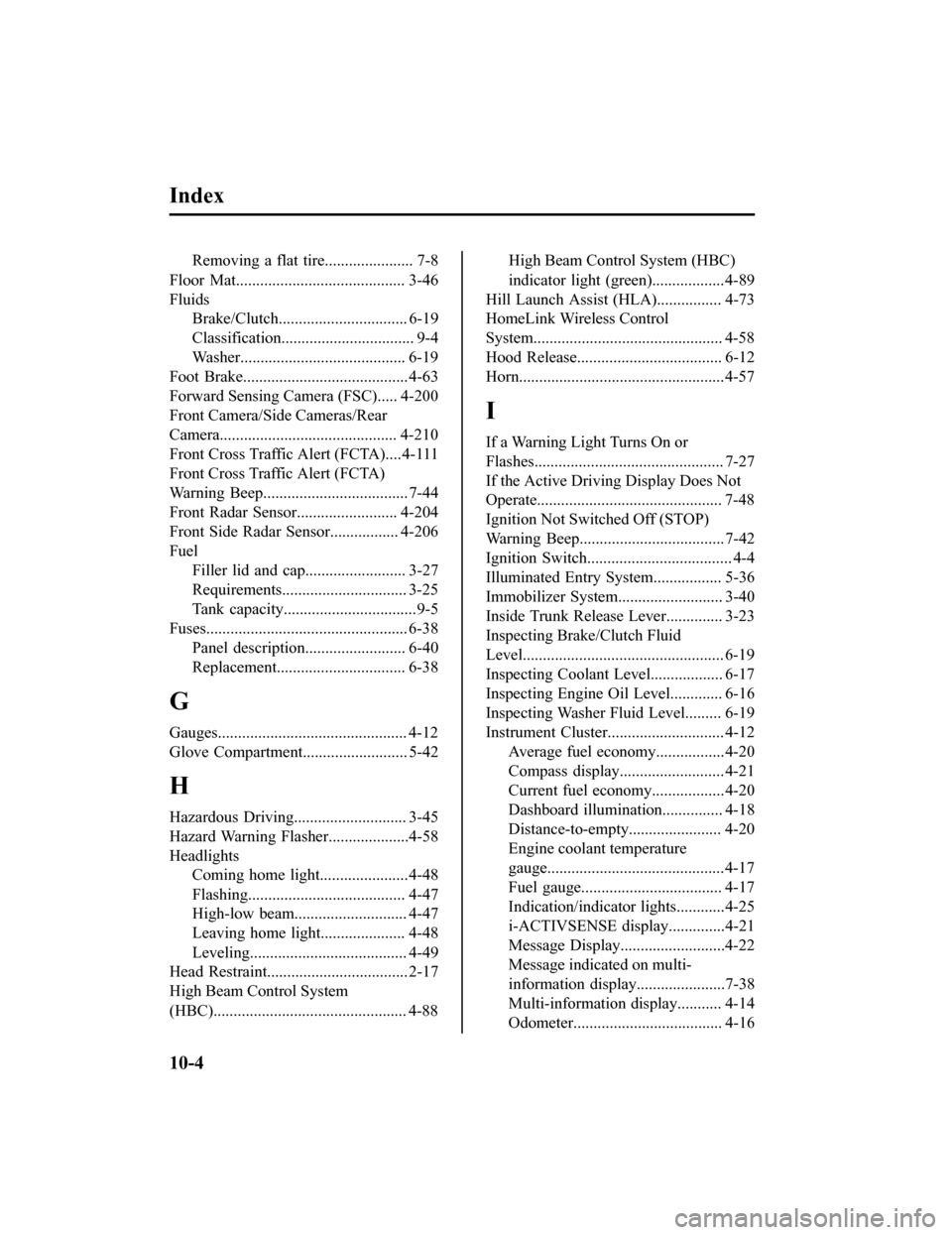
Index
Removing a flat tire...................... 7-8
Floor Mat.......................................... 3-46
Fluids Brake/Clutch................................ 6-19
Classification................................. 9-4
Washer......................................... 6-19
Foot Brake.........................................4-63
Forward Sensing Camera (FSC)..... 4-200
Front Camera/Side Cameras/Rear
Camera............................................ 4-210
Front Cross Traffic Alert (FCTA)....4-111
Front Cross Traffic Alert (FCTA)
Warning Beep.................................... 7-44
Front Radar Sensor...... ................... 4-204
Front Side Radar Sensor................. 4-206
Fuel
Filler lid and cap......................... 3-27
Requirements............................... 3-25
Tank capacity.................................9-5
Fuses.................................................. 6-38 Panel description......................... 6-40
Replacement................................ 6-38
G
Gauges............................................... 4-12
Glove Compartment.......................... 5-42
H
Hazardous Driving............................ 3-45
Hazard Warning Flasher....................4-58
HeadlightsComing home light......................4-48
Flashing....................................... 4-47
High-low beam............................ 4-47
Leaving home light..................... 4-48
Leveling....................................... 4-49
Head Restraint................................... 2-17
High Beam Control System
(HBC)................................................ 4-88
High Beam Control System (HBC)
indicator light (green)..................4-89
Hill Launch Assist (HL A)................ 4-73
HomeLink Wireless Control
System............................................... 4-58
Hood Release............. ....................... 6-12
Horn...................................................4-57
I
If a Warning Light Turns On or
Flashes............................................... 7-27
If the Active Driving Display Does Not
Operate.............................................. 7-48
Ignition Not Switched Off (STOP)
Warning Beep.................................... 7-42
Ignition Switch.................................... 4-4
Illuminated Entry System................. 5-36
Immobilizer System..... ..................... 3-40
Inside Trunk Release Lever.............. 3-23
Inspecting Brake/Clutch Fluid
Level.................................................. 6-19
Inspecting Coolant Level.................. 6-17
Inspecting Engine Oil Level............. 6-16
Inspecting Washer Fluid Level......... 6-19
Instrument Cluster............................. 4-12 Average fuel econom y.................4-20
Compass display.......................... 4-21
Current fuel economy. .................4-20
Dashboard illuminati on............... 4-18
Distance-to-empty... .................... 4-20
Engine coolant temperature
gauge............................................4-17
Fuel gauge................................... 4-17
Indication/indicator lights............4-25
i-ACTIVSENSE display..............4-21
Message Display..........................4-22
Message indicated on multi-
information display......................7-38
Multi-information display........... 4-14
Odometer..................................... 4-16
10-4
Mazda3_8HZ1-EA-19G_Edition1_old 2019-5-17 13:49:03
Page 593 of 598
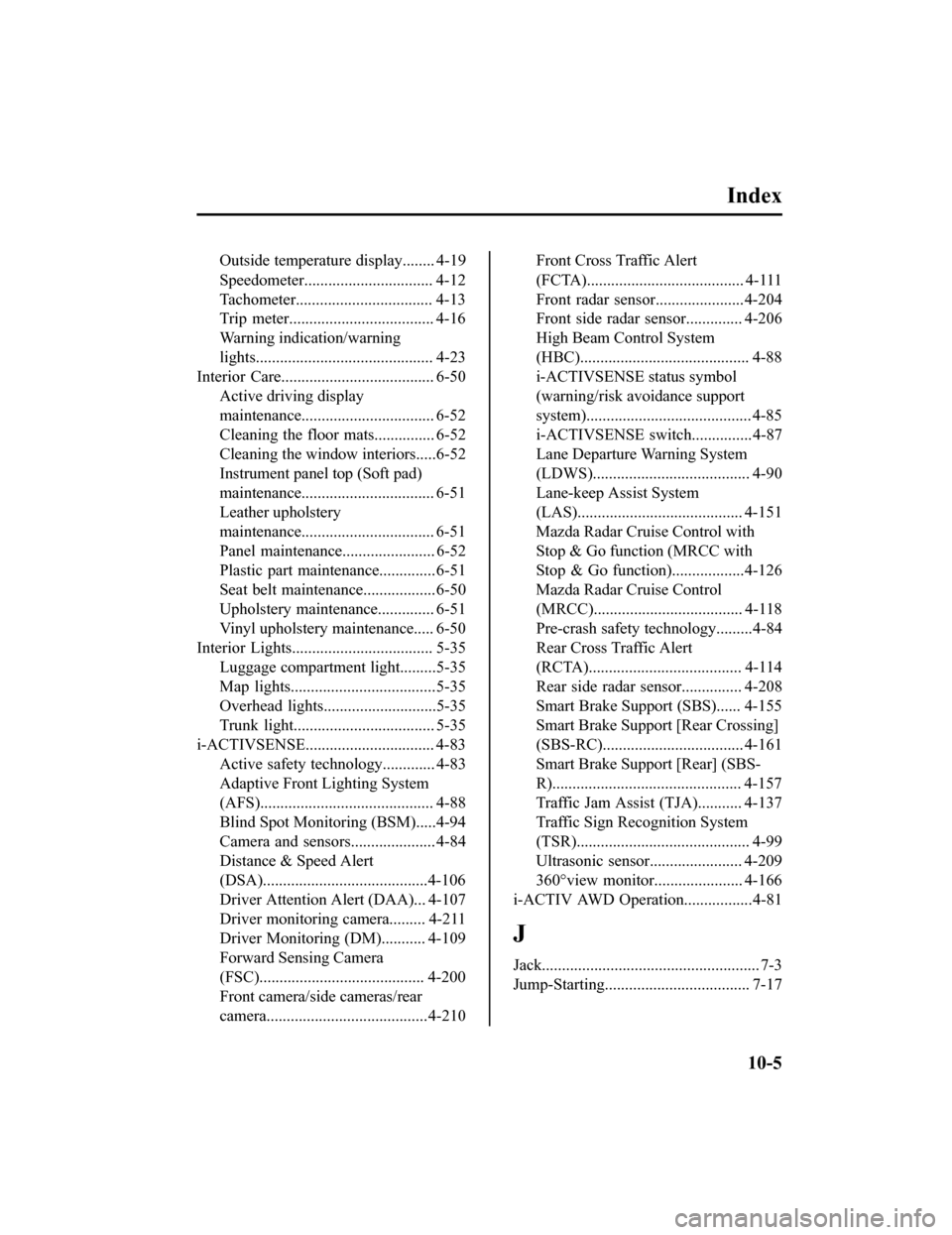
Index
Outside temperature display........ 4-19
Speedometer................................ 4-12
Tachometer.................................. 4-13
Trip meter.................................... 4-16
Warning indication/warning
lights............................................ 4-23
Interior Care...................................... 6-50
Active driving display
maintenance................................. 6-52
Cleaning the floor mats............... 6-52
Cleaning the window interiors.....6-52
Instrument panel top (Soft pad)
maintenance................................. 6-51
Leather upholstery
maintenance................................. 6-51
Panel maintenance....................... 6-52
Plastic part maintenance.............. 6-51
Seat belt maintenance..................6-50
Upholstery maintenan ce.............. 6-51
Vinyl upholstery maintenance..... 6-50
Interior Lights................................... 5-35 Luggage compartment light.........5-35
Map lights....................................5-35
Overhead lights............................5-35
Trunk light........ ........................... 5-35
i-ACTIVSENSE................................ 4-83 Active safety tec hnology............. 4-83
Adaptive Front Lighting System
(AFS)........................................... 4-88
Blind Spot Monitoring (BSM).....4-94
Camera and sensors..................... 4-84
Distance & Speed Alert
(DSA).........................................4-106
Driver Attention Alert (DAA)... 4-107
Driver monitoring camera......... 4-211
Driver Monitoring ( DM)........... 4-109
Forward Sensing Camera
(FSC)......................................... 4-200
Front camera/side cameras/rear
camera........................................4-210Front Cross Traffic Alert
(FCTA)....................................... 4-111
Front radar sensor......................4-204
Front side radar sensor.............. 4-206
High Beam Control System
(HBC).......................................... 4-88
i-ACTIVSENSE status symbol
(warning/risk avoidance support
system)......................................... 4-85
i-ACTIVSENSE switch...............4-87
Lane Departure Warning System
(LDWS)....................................... 4-90
Lane-keep Assist System
(LAS)......................................... 4-151
Mazda Radar Cruise Control with
Stop & Go function (MRCC with
Stop & Go function)..................4-126
Mazda Radar Cruise Control
(MRCC)..................................... 4-118
Pre-crash safety technology.........4-84
Rear Cross Traffic Alert
(RCTA)...................................... 4-114
Rear side radar sensor............... 4-208
Smart Brake Support (SBS)...... 4-155
Smart Brake Support [Rear Crossing]
(SBS-RC)................................... 4-161
Smart Brake Support [Rear] (SBS-
R)............................................... 4-157
Traffic Jam Assist (TJA)........... 4-137
Traffic Sign Recognition System
(TSR)........................................... 4-99
Ultrasonic sensor....................... 4-209
360°view monitor..... ................. 4-166
i-ACTIV AWD Operation.................4-81
J
Jack...................................................... 7-3
Jump-Starting.................................... 7-17
10-5
Mazda3_8HZ1-EA-19G_Edition1_old 2019-5-17 13:49:03